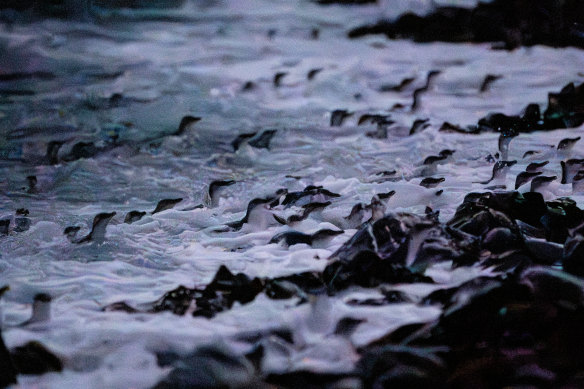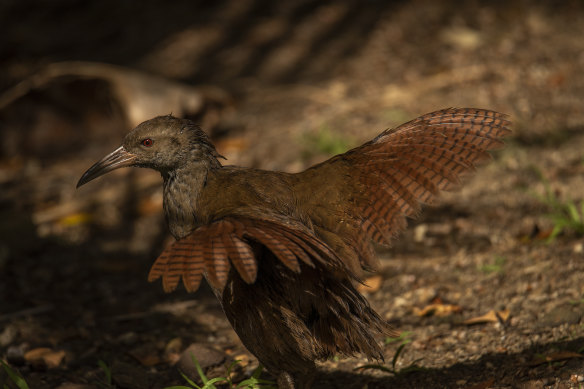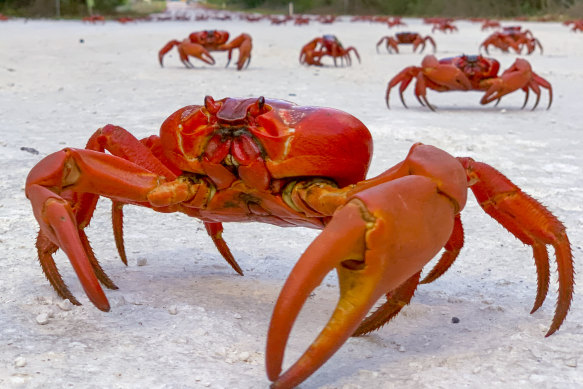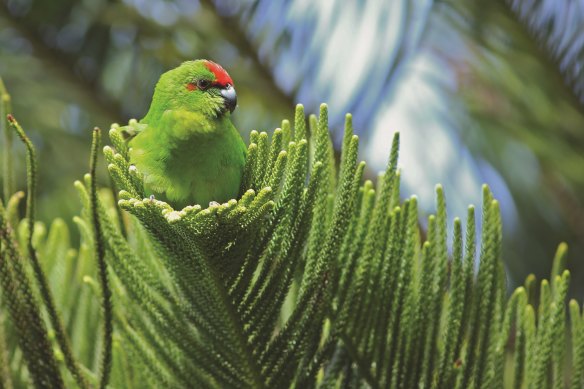This was published 1 year ago
Islands of hope: The fight to eradicate feral pests and save native wildlife
By Mike Foley
Australia’s islands are a haven for some of the world’s rare and unique species, but a motley crew of feral cats, foxes, rats, goats and other invasive species are wrecking these refuges and eating native animals out of their homes.
But hope is at hand, and according to experts, the solution won’t cost the earth.

Efforts to curb fox numbers on Phillip Island has preserved colonies of little penguins.Credit: Phillip Island Nature Parks
The islands off Australia’s mainland are proving some of the best places in the world to eradicate invasive pests and restore threatened native wildlife back to health.
An ongoing national fund of $16 million a year, that would be ideally jointly funded by state and federal governments, would be enough to run a national island pest eradication program and restore native wildlife back to health.
That’s according to the Invasive Species Council, which is lobbying the federal and state governments for an ongoing islands fund, that it says would be crucial to deliver certainty to pest eradication programs that can take years, or even decades, to complete.
Australia’s extinction rate is one of the worst in the world, with about 100 of the country’s unique flora and fauna species wiped out since colonisation. Additionally, 1900 threatened species are now at a heightened risk of extinction.
There are more than 8000 islands around the country, and on some invasive pests are a leading cause of wildlife losses. Rats eat seabird eggs and even the young of some mammals, foxes and cats are a top predator to birds and small marsupials, and rabbits, pigs and goats compete for food resources and trample habitat.
Federal Environment Minister Tanya Plibersek has promised to halt native species extinctions, but scientists say more funding is needed, including for islands.
“Islands are at the forefront of extinctions in Australia and have been for the last couple of hundred years because they are restricted environments,” Invasive Species Council advocacy director Jack Gough said.
“When an invasive species like a cat or a fox, or weeds take over that area, they can wipe out the native species that aren’t used to having those predators or that competition.”

The Lord Howe woodhen faced extinction, but its population has since boomed.
Government-backed eradication programs, which typically take years of painstaking trapping, culling and groundwork since 1980, have eradicated feral populations of rodents, cats, pigs, goats and even the myrtle rust fungus from the World Heritage-listed Lord Howe Island.
For example, the unique Lord Howe woodhen population had shrunk to less than 100. But for just $25 million over a decade, rats and mice were eradicated by 2021 and the number of woodhens has boomed to more than 1000.
“Locals are now so overwhelmed by the numbers of woodhens that some are complaining they’re actually stopping traffic on the island, which just shows you the extent of that rapid recovery of a bird that could have gone extinct,” Gough said.
“If we can remove invasive species, not only will we see the recovery of these island environments, but we can also start to reintroduce animals or plants that have been wiped out.”

Red crabs can migrate again on Christmas Island now that the ant problem has been tackled.
Lord Howe Island is a remote territory in Plibersek’s Sydney electorate. She has visited 25 times and witnessed it bounce back after ferals were removed.
“The ground is now carpeted with the endemic palms which had been non-existent when the rodents were eating the seeds. It’s transformational,” she said.
Plibersek did not commit to a dedicated island fund, but said the Albanese government had pledged $550 million for conservation and feral eradication.
“I would love to see islands that have eradicated feral and invasive species reintroduce native species that have become locally extinct,” she said.
For Christmas Island, the government has committed $4 million for cat eradication and $2 million to control yellow crazy ants.
Controlling the ants has helped double the island’s red crab population to more than 100 million, while the removal of 300 feral cats has saved an estimated 11,00 giant geckos, 4000 threatened birds and about 400 critically endangered flying foxes.
The world’s largest fox eradication program was completed on Victoria’s Phillip Island in 2015 to save little penguins. On Macquarie Island, in Australia’s Antarctic territory cats, black rats and rabbits were banished a decade ago to protect a multitude of endangered seabirds and restore the native vegetation that is crucial to their survival.
Kangaroo Island is a haven for an array of unique species like Rosenberg’s goanna, the local dunnart and echidna, as well as the bush stone-curlew, glossy black cockatoo and southern brown bandicoot. Goats, deer and pigs have been eradicated, but removing cats is a work in progress.

Norfolk Island’s endemic green parrot is on the brink of extinction due to predation by black rats and feral cats.
The world’s largest cat eradication program was completed on Dirk Hartog Island, in Western Australia, in 2018, after feral sheep were eradicated in 2005 and goats in 2017. Together, these animals had wiped out 10 of the island’s 13 ground-dwelling mammal species.
Now, some of those mammals are being reintroduced from the mainland to add to the Dirk Hartog populations of seabirds, turtles, rufous hare-wallabies, banded hare-wallabies, Shark Bay bandicoots, greater stick-nest rats, Shark Bay mice, dibblers and western grass wrens.
Norfolk Island is one of the most prominent examples of an Australian island facing the threat of more species extinctions due to invasive pests. As well as a dozen plant and reptile species, the island’s endemic green parrot is on the brink of extinction due to predation by black rats and feral cats, and competition for nesting hollows with the crimson rosella. The rosella was introduced from the mainland.
Biodiversity Council member Professor Sarah Legge said once an invasive pest was wiped from an island, the cost of preventing its return – with biosecurity measures to ban people bringing cats, foxes and other pests ashore – was relatively cheap.
She said the cost of island biosecurity was far cheaper than the alternative on the mainland, where huge fences are erected around bushland reserves to create a sanctuary for endangered species.
“Island eradication is a really great way to secure the future of populations of mammals and seabirds, and it’s very cost-effective. Once the eradication is complete the ongoing cost to maintain it is minimal,” said Legge, a professor of wildlife ecology at the Australian National University.
Queensland University of Technology conservation scientist Dr Justine Shaw said predators such as cats and rats were a greater risk to native animals on islands compared to mainland populations.
“Islands have boundaries and the animals can’t move or migrate away from their threats,” Shaw said.
“On the mainland, a species like the eastern barred bandicoot, which is a threatened species, will have cats within its range. But because its habitat is widespread, there will be pockets without cats that it can move into to survive.
“But on islands, those boundaries are finite, so there’s only so far they can go to evade invasive species.”
Get to the heart of what’s happening with climate change and the environment. Sign up for our fortnightly Environment newsletter.